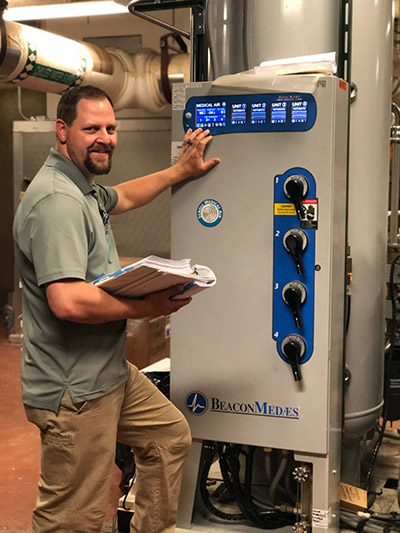Environmental Testing


Total care service means we keep you safe too
Checking the air you breathe is part of our job; it’s what we do. It’s part of total care mentality.
As you know, healthcare workers contend with various airborne hazards, both chemical and biological. To minimize exposure, proper work environment ventilation is key. And we can help. Our long history in providing ventilation testing to acute care facilities, hospitals, clinics and private offices is well respected.
The amount of ventilation a room receives is expressed as: the number of times air within the room is exchanged per hour. By measuring the ventilation rates of rooms where hazards are present, including rooms where anesthetic gases are delivered or stored, healthcare facilities comply with regulatory agency recommendations for Ambient Air Monitoring.
Importance of Monitoring and Testing
Healthcare workers in a variety of settings can be exposed to the anesthetic gases that leak out during medical procedures. These gases and vapors are known as waste anesthetic gases (WAGs). People who work in hospital areas such as operating rooms, recovery, and delivery rooms as well as dental offices and veterinary clinics can be exposed to dangerous and harmful levels of waste anesthetic gases. In fact, studies from the N.I.O.S.H. have concluded that exposure to N2O decreases mental performance, audiovisual ability and dexterity. Plus recent research finds workers who’ve indicated that adverse reproductive effects might also result from chronic exposure to N2O.
Monitoring can be continuous or periodic but should adequately measure exposure in the proper areas. Monitoring can aid in identifying the presence and location of leaked gases and the effectiveness of corrective measures.
As most halogenated anesthetic gases cannot be detected by smell (unless they are in high concentration) proper monitoring becomes all the more critical.
We will perform a real-time measurement of waste anesthetic gas levels and N20 leaks in exposed areas as well as gas delivery hoses, gas supply wall outlets and columns utilizing a portable infrared gas analyzer as recommended by NIOSH Analytical method 6600.
We will always deliver a comprehensive report detailing our findings and recommendations for you to use and store.
Let us help you. Our technicians will test for waste anesthetic gas to ensure proper room ventilation and room pressure and provide documentation to support your facilities compliance with NIOSH Publication No. 77-140 and the Joint Commission accreditation requirement 7.10.16.

